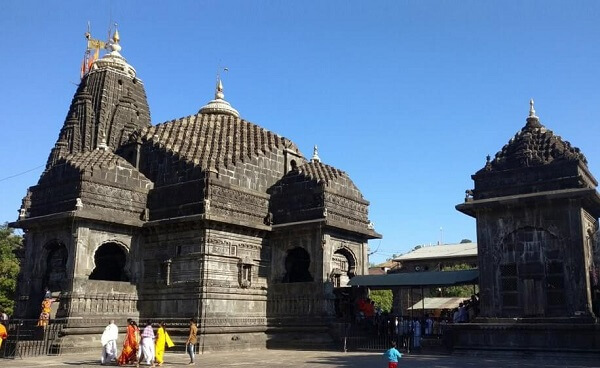
A 28 km (18 miles) journey from pilgrim town Nashik takes a tourist to Trimbakeshwar, 10th sacred Jyotirlinga in the Dwadash Jyotirlinga circuit. The place is memorable due to its picturesque hills, roads and cool breeze. This hill station like place lies in the formidable shadow of Brahmagiri hills in the Sahyadri range and it is the source of holy river Godavari. The place is also known for its Simhastha Kumbha Mela, which comes every 12 years as per the Hindu calendar.
What makes the Trimbakeshwar Jyotirlinga unique is that it has three faces embodying Lord Brahma, Lord Vishnu, Lord Mahesh(Shiva). All other Jyotirlingas have Shiva as the main deity. The temple is known for its appealing architecture and sculpture.
Trimbakeshwar Jyotirlinga is in a small hollow space, which contains a pot of water. Water from the river Godavari constantly pours on the top of linga. The Jyotirlinga is unique as it has three faces embodying Lord Brahma, Lord Vishnu, Lord Mahesh (Shiva). Generally, the Jyotirlinga has a silver cover on festive occasions it is adorned with a golden cover of five faces each with a golden crown.
There are two stories related to Trimbakeshwar. One story is about Simhastha Parva according to Padma Puran. Centuries ago the gods and goddesses used to roam in India. They helped sages and people living here at the time of various difficulties, especially from the demons who were a nuisance. However, this fight generally caused heavy damages to both, gods and demons. It was decided to settle the issue of supremacy once for all. They agreed that whosoever captures Amritakumbha (immortal nectar) will be the victor. Amritakumbha (pot with immortal nectar) was on the sea bed.
The gods successfully procured nectar through cunning, outwitting the demons. Upon discovering this, the demons launched a fierce battle for the immortal nectar, leading to drops falling at four locations: Haridwar, Prayag, Ujjain, and Trimbakeshwar. Trimbakeshwar is one of these four sacred spots where celestial nectar descended. This event coincided with the planet Jupiter (Guru) entering the Leo (Simha) constellation. Given that this alignment recurs every 12 years, the Kumbh Mela is observed once every 12 years in these respective areas. Explore this divine narrative with the assistance of Tirth Yatra India , dedicated to enriching your journey.
The other story is equally interesting. Sage Gautam used to live in this area. Once there was severe drought for 24 years. To come to the rescue of people, sage Gautam worshipped Lord Varun (rain god) and the god was pleased. He blessed the sage with the gift of plenty of rains in the area. This made the area lush green and full of water.But this made other sages jealous of Gautam. They sent a cow to destroy the granary of Gautam. When Gautam tried to shoo her away, she was injured and died. Waiting for such an opportunity, other sages charged Gauam of great sin of killing mother cow and made him go for penance. He was asked to worship Lord Shiva and bathe in Ganga.
Gautam appeased Lord Shiva who in turn asked Ganga to come to Gautam's place. Gauatm and Ganga prayed to Lord Shiva to come here with Parvati and stay with them. They made Lord Shiva agree to the request and he decided to settle here. Here the river Ganga appeared in the form of river Godavari. Hence it is also known as Ganga Godavari or Gautami Godavari. People here worship the Godavari as Ganga. Lord Shiva also resides here in the form of Trimbakeshwar.
Trimbakeshwar Temple The present structure of the temple complex was built by Nana Saheb Peshwa during his regime between 1755-1768.It is Hemad Panthi style temple and its architecture is shaped mechanically. It is East facing temple and surrounded by four sides with stone walls. Trimbakeshwar temple has 5 domes and each tomb has five golden pots. The flag of the temple is made of the 5 substances. The flag and the golden pots were donated by Anna Saheb Vichurkar.
The lotus flowers behind the idol look real. There is arrangement for devotees to stand in a queue during darshan time. On the entrance a small temple of Nandi comes first. There is a small hall or sabhamandap to assemble. Here purohits perform different pujas.
Pancha tirtha yatra includes Gangadwar, Kushavarta, Bilwaka, Neel Parvat and Kanakhala tirtha. It is believed that one who takes a bath in the above frees himself from the cycle of life and death.
Kushavrata Tirtha is a main place of pilgrim attraction during the Simhastha Kumbha mela. Devotees come to have a bath in this holy pond and become free of results of their sins. It is just 200 meter away from main Trimakeshwar temple complex. Today's structure was built by Bala Saheb of Holkar regime in 1690-91 at the cost of Rs.8 lacs.I t's a beautiful example of sculpture with graceful look. All around the tirtha are temple shaped tombs. The golden pot at top of the temple was donated by Anna Saheb Vichurkar. The importance of this place is that the Godavari river descends from its origin in the Brahmgiri Hill and merges into the Kushavrata Tirtha.The Kedarnath temple is on the southern end of this pond. The temple has some exquisite carvings depicting the forms of Lord Shiva. Most devotees take a dip in the pond which is 21 feet deep but shallow near the steps. Behind the Kedareshwar temple there is a place to change the clothes for ladies. The tirtha remain opens 24 hours.
Gautama Tirtha is to the south of the Ganga and the Trimbakeshwar temple. God of water Varun was pleased with Gautama and he gave this tirtha as a permanent source of water. To the north is Gautameshwar and to the south is Rameshwar Mahadev.
Indra Tirtha is to the east and near Kushavarta. This is known as Shakra-Kupa for Indra wiped off his curse given by sage Gautama for enjoying Ahilya, by a bath in this tirtha.. On the bank of the tirtha is a beautiful temple of Indreshwar Mahadev with an idol of Indra seated on an Airavata elephant. Ahilya Sangam tirtha : There is an interesting story about this thirth. It is said that a friend of Gautam took the form of Gautam's wife Ahilya. He approached Gautam to end his penance. But Gautam detected the game plan and he cursed his friend Jatila to turn into a river. Shocked by this , Jatila asked Gautam to take back his curse. Gautam did and told Jatila that he would be free of his curse This is the Ahilya-Sangam tirtha where Ganga and Godavari join. Places around Trimbakeshwar Apart from Kushavrata Tirtha and main Jyotirlinga temple, there are many places of tourist interest around Trimbakeshwar.
The place is 2 km away from Trimbakeshwar temple. It is the shrine with a narrow colourful dome houses the samadhi of Sant Nivrutti Nath. He was the elder brother of Maharastra's most famous saint Dhyaneshwar. Nivrruttinath was the first to achieve sainthood in Varkari Sampradaya and he guided all his three siblings. The place remains open between 5 am tand 10 pm daily.
Neel Parvat is located in the north of the Trimbakshwar city and it is one of the five major pilgrim places. The visitors normally comes in the late afternoon or early morning to visit this place.The 200 steps climb takes 45 minutes to one hour.If one can not climb the mount,ther is also an option to hire an auto rickshaw for Trimbakeshwar temple-Neel Parvat round trip and it charges around Rs.60 to Rs.75. It's a walking distance from the Trimbakeshwar bus stand.
Shreemant Seth Kapol has built about 200 steps. On the summit is the temple of Nilambika and Matamba Devi, further on is an ancient temple of Nilkantheshwar Mahadev and an idol of Parashuram. There is an old akhada(Matha) called Dashnami Panchayati Akhadaor matha of the Naga Gosavi sect and an ancient temple of Sadguru Dattatreya. There are many temples apart from this.The temples are very clean and are situated in a row,close to each other.
Climbing the Brahmagiri Hill which is 4248 feet high is also a must do for the mountain lovers when they visit Trimbakeshwar.It is 2.5 km north of Trimbakeshwar Temple.Original Ganges and Trimbak Tirtha are on Brahmagiri mountain adjacent to Trimbakeshwar temple. Brahmagiri is considered as a huge form of Lord Shiva and hence the mountain climbing was considered as a sin. However in 1908 Seth Lalchand Jashodanand Bhambhani of Karachi and Seth Ganeshdas built 500 steps of stone at a cost of Rs. 40,000 then. This has facilitated easy access to Brahmagiri. Here river Godavari is flowing in three directions on the mountain. The one flowing towards east is called Godavari, one flowing towards the south is called Vaitarna and the one flowing towards the west is called the west-flowing Ganga and meets Godavari near Chakra Tirth. The first peak of Sahyadri is called Brahmagiri. The story associated with this is that Lord Shiva was pleased with Brahmadev and said that he will be known by name of Brahmadev. Hence it is called as Brahmagiri. The Five peaks of this mountain are called Sadyo-Jata, Vamdev, Aghora, Ishana and Tat-Purusha and are considered as five mouths of the Lord Shiva and they are worshipped.
Ganngdwar is situated in right of the middle of Brahmagiri Mountain. There is a temple of Ganga, now known as Godavari River. Ganga appears first time here, after it vanishes from Brahmagiri Mountain.There are 750 steps to Gangadwar. They were built by Sheth Karamasi Hansraj of Kutch, Gujarat. The work was commenced in 1907 and was completed in 1918.Sheth Hansraj also built road for the visitors.Gangadwar is one of the five tirthas. There is an idol of Ganga and 108 shivalingas installed by Rishi Gautam.The caves of Gorakhnath is also situated at this place.
The saint Gorakhnath who born in 11th century had established Nath Sampraday or Nath movement.He became well known in India.He showed many miracles of Yoga.He preached to Nivruttinath and granted him the initiation of Nath community.The samadhi temple is near trimbakeshwar temple.
It is situated about 2 km from Trimbakeshwar Temple.Swami Smarth was a very popular Spiritual Guru in Maharastra in the 19th century .The temple is spacious and clean.The temple faces Sahyadri and Trimbak hence offers a beautiful view. It remain opens all the day.
If Devotee has time in hand, he must visit Sri Shirdi Sai temple in Shirdi and Sri Shani Shinganapur temple too which are not too far away from Trimbakeshwar.
Do you have any questions?
Don't hesitate to call us. We are a team of experts and we are happy to talk to you.
Teen Dham 11 Jyotirlinga Tirth Yatra- 34 Days
Main Attractions: 11 Jyotirlingas, Kishor Dham, Ganga Sagar, Nepal, Kathmandu
Departure: 17 Aug 2025
Ek Dham Jagannath Puri Gangasagar Tirth Yatra- 16 Days
Main Attractions: Jagannath Puri Dham, Baijnath Dham, Gangasagar, Ayodhya, Allahabad
Departure: 10 Sep 2025
Ek Dham Dwarka Puri Yatra - 12 Days
Main Attractions: Dwarka Puri Dham, Seven Jyotirlingas, Statue of Unity
Departure: Coming Soon
Braj Chaurasi Kos Yatra - 10 Days
Main Attractions: Mathura, Vrindavan, Nandgaon, Barsana, Govardhan Parikrama, Braj Chaurasi Kos Yatra
Departure: 29 Oct 2025
We conduct tirth yatrain an organized manner in which the pilgrims are provided good quality food, Satsang programmes, medical facilities.




